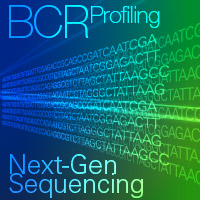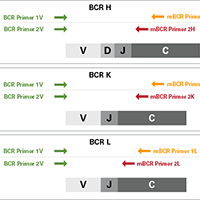SMARTer Mouse BCR IgG H/K/L Profiling Kit—capturing complete V(D)J variable regions of BCR transcripts

The SMARTer Mouse BCR IgG H/K/L Profiling Kit pairs 5' RACE with NGS technology to provide a sensitive, accurate, and optimized approach to BCR profiling. The 5'-RACE method reduces variability and allows for priming from the constant region of BCR heavy or light chains. This kit combines these benefits with gene-specific amplification to capture complete V(D)J variable regions of BCR transcripts and provide a highly sensitive and reproducible method for profiling B-cell repertoires.
The SMARTer Mouse BCR IgG H/K/L Profiling Kit pairs 5' RACE with NGS technology to provide a sensitive, accurate, and optimized approach to BCR profiling. The 5'-RACE method reduces variability and allows for priming from the constant region of BCR heavy or light chains. This kit combines these benefits with gene-specific amplification to capture complete V(D)J variable regions of BCR transcripts and provide a highly sensitive and reproducible method for profiling B-cell repertoires.
The kit is designed to work with a range of RNA input amounts depending on the sample type, and has been shown to generate high-quality, Illumina-ready libraries from as little as 10 ng to 3 µg of total RNA from spleen, lymph node, peripheral blood mononuclear cells (PBMCs), and hybridomas.
Downstream sequencing of H/K/L chains allows for accurate identification of top clonotypes and reliable assignment of isotype in a majority of cases.
Overview
- Input: 10 ng–3 µg of total RNA from spleen, lymph node, PBMCs, and hybridomas
- Sensitive and specific clonotype detection with optimized cDNA library generation
- Accurate amplification of mouse IgG subclasses and identification via sequencing in a majority of cases
- Optimized PCR pooling strategy for highly sensitive detection of different chains from the same sample
- Flexible pooling strategies accommodate different experimental requirements regarding alignment and identification of primary chain sequences
More Information
Applications
- Mouse BCR repertoire analysis (heavy and light [kappa and lambda] chains)
Additional product information
Please see the product's Certificate of Analysis for information about storage conditions, product components, and technical specifications. Please see the Kit Components List to determine kit components. Certificates of Analysis and Kit Components Lists are located under the Documents tab.

Specific, accurate amplification for BCR repertoire profiling
The SMARTer Mouse BCR IgG H/K/L Profiling Kit leverages SMART technology and employs a 5' RACE-like approach to capture complete V(D)J variable regions of BCR transcripts. Read the tech note for key technical features and workflow advantages, as well as application data on amplification of heavy and light chains, clonotype detection, and PCR pooling strategies.
View dataTakara Bio USA, Inc.
United States/Canada: +1.800.662.2566 • Asia Pacific: +1.650.919.7300 • Europe: +33.(0)1.3904.6880 • Japan: +81.(0)77.565.6999
FOR RESEARCH USE ONLY. NOT FOR USE IN DIAGNOSTIC PROCEDURES. © 2025 Takara Bio Inc. All Rights Reserved. All trademarks are the property of Takara Bio Inc. or its affiliate(s) in the U.S. and/or other countries or their respective owners. Certain trademarks may not be registered in all jurisdictions. Additional product, intellectual property, and restricted use information is available at takarabio.com.



